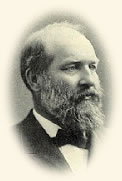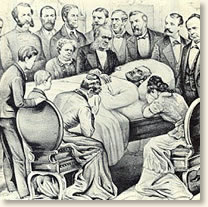|
The Death Of President Garfield, 1881
Less than four months after his inauguration, President
Garfield arrived at the Washington railroad depot on July 2, 1881, to catch a
train for a summer's retreat on the New Jersey seashore. As Garfield made his
way through the station, Charles Guiteau raced from the shadows and fired two
shots point blank into the president. One grazed Garfield's arm; the other lodged
in his abdomen. Exclaiming, "My God, what is this?" the president collapsed to the floor remaining fully conscious, but in a great deal of pain.
 |
The assassination
of President Garfield
|
The first doctor on the scene administered brandy and spirits of ammonia, causing the president to promptly vomit. Then D. W. Bliss, a leading Washington doctor, appeared and inserted a metal probe into the wound, turning it slowly, searching for the bullet. The probe became stuck between the shattered fragments of Garfield's eleventh rib, and was removed only with a great deal of difficulty, causing great pain. Then Bliss inserted his finger into the wound, widening the hole in another unsuccessful probe. It was decided to move Garfield to the White House for further treatment.
Leading doctors of the age flocked to Washington to aid in his recovery, sixteen
in all. Most probed the wound with their fingers or dirty instruments. Though
the president complained of numbness in the legs and feet, which implied the
bullet was lodged near the spinal cord, most thought it was resting in the
abdomen. The president's condition weakened under the oppressive heat and humidity
of the Washington summer combined with an onslaught of mosquitoes from a stagnant
canal behind the White House. It was decided to move him by train to a cottage
on the New Jersey seashore.
Shortly after the move, Garfield's temperature began to elevate; the doctors reopened the wound and enlarged it hoping to find the bullet. They were unsuccessful. By the time Garfield died on September 19, his doctors had turned a three-inch-deep, harmless wound into a twenty-inch-long contaminated gash stretching from his ribs to his groin and oozing more pus each day. He lingered for eighty days, wasting away from his robust 210 pounds to a mere 130 pounds. The end came on the night of September 19. Clawing at his chest he moaned, "This pain, this pain," while suffering a major heart attack. The president died a few minutes later.
Garfield's physicians did not serve him well. It seems each of his 16 attendants wanted to literally get their hands into him - to prod and grope his wound in an attempt to find the elusive bullet. Infection invariable set in. Internal sores developed - oozing pus and requiring periodic lancing in order to reduce their size. Medicine had not yet fully accepted the relationship between germs and disease. Operations were routinely performed without benefit of surgical gloves, masks, sterile instruments, or any antiseptics to protect the patient. Of more immediate concern to the patient, operations were performed without any means of deadening the pain. The patient was left to his or her own devices to cope with the trauma of surgery.
Garfield was not a particularly popular president. His short span of office had not been long enough for the public to form an opinion one way or the other. However, the stoic manner in which he endured his wounds warmed the popular attitude towards him.
Garfield's chief physician, Dr. D. W. Bliss recounts how the president coped with his condition:
"At this time, as is known, a simple but painful operation was rendered necessary
by the formation of a superficial pus-sac. When, after consultation, I informed
the President of the intention to use the knife, he with unfailing cheerfulness
replied: 'Very well; whatever you say is necessary must be done.' When I handed
the bistoury to one of the counsel, with the request that he make the incision.
Without an anesthetic, and without a murmur, or a muscular contraction by the
patient, the incision was made. He quietly asked the results of the operation,
and soon sank into a peaceful slumber. This operation, though simple in itself,
 |
| President Garfield |
was painful, and the manner in which it was borne by the President in his enfeebled
condition was, perhaps, as good an instance as any of the wonderful nervous control
which characterized his whole illness. This power of mind over body was also
daily exhibited at the dressings of his wound, which were unavoidably painful,
and yet invariably borne without indication of discomfort; and also at subsequent
operations, always painful."
When the decision was made to move the president to New Jersey, an English nobleman offered the use of his twenty-room home on the seashore. Special track was laid from the railroad's mainline to the door of the home. During the early hours of September 6, hushed crowds lined Pennsylvania Avenue as Garfield was moved by carriage from the White House to the railroad depot.
Dr. Bliss continues his story:
"Mrs. Garfield sat by the side of her husband during the first part of the trip, cheering and reassuring him as no one else could, and visited him afterward, frequently, from her own car. On arriving at the track recently laid to the Francklyn Cottage, we were surrounded by a large concourse of people, who braved the heat of the day in the anxiety lest the journey might have resulted disastrously. The engine had not weight and power sufficient to push us up the steep grade. Instantly hundreds of strong arms caught the cars, and silently, but resistlessly, rolled the three heavy coaches up to the level. Arriving at the cottage, the President was placed upon a stretcher, and borne under the canopy previously arranged, to the room wherein the remainder of a noble life was spent."
During the evening of September 16, Dr. Bliss passed the time reading when a servant rushed in announcing a change in the President's condition:
"At 10:10 I was looking over some of the wonderful productions of the human imagination which each mail brought me, when the faithful Dan suddenly appeared at the door of communication, and said;
 |
The death of President Garfield,
a contemporary portrayal
|
'General Swaim wants you quick!' He preceded me to the room, took the candle
from behind the screen near the door, and raised it so that the light fell
full upon the face, so soon to settle in the rigid lines of death. Observing
the pallor, the upturned eyes, the gasping respiration, and the total unconsciousness,
I, with uplifted hands, exclaimed, 'My God, Swaim! The President is dying!'
Turning to the servant, I added, 'Call Mrs. Garfield immediately, and on your
return, Doctors Agnew and Hamilton.' On his way to Mrs. Garfield's room, he
notified Colonel Rockwell, who was the first member of the household in the
room. Only a moment elapsed before Mrs. Garfield was present. She exclaimed,
'Oh! what is the matter?' I said, 'Mrs. Garfield, the President is dying.'
Leaning over her husband and fervently kissing his brow, she exclaimed, 'Oh!
Why am I made to suffer this cruel wrong?'
While summoning Mrs. Garfield, I had in vain sought for the pulse at the wrist, next at the carotid artery, and last by placing my ear over the region of the heart. Restoratives, which were always at hand, were instantly resorted to. In almost every conceivable way it was sought to revive the rapidly yielding vital forces. A faint, fluttering pulsation of the heart, gradually fading to indistinctness, alone rewarded my examinations. At last, only moments after the first alarm, at 10:35, I raised my head from the breast of my dead friend and said to the sorrowful group, 'It is over.'
Noiselessly, one by one, we passed out, leaving the broken-hearted wife alone with her dead husband. Thus she remained for more than an hour, gazing upon the lifeless features, when Colonel Rockwell, fearing the effect upon her health, touched her arm and begged her to retire, which she did."
References:
Bliss, D. W., The Story Of President Garfield's Ilness, Century Magazine (1881); Marx, Rudolph, The Health of the Presidents (1960); Taylor, John M., Garfield of Ohio (1970).
How To Cite This Article:
"The Death Of President Garfield, 1881" EyeWitness to History, eyewitnesstohistory.com (1999).
|






